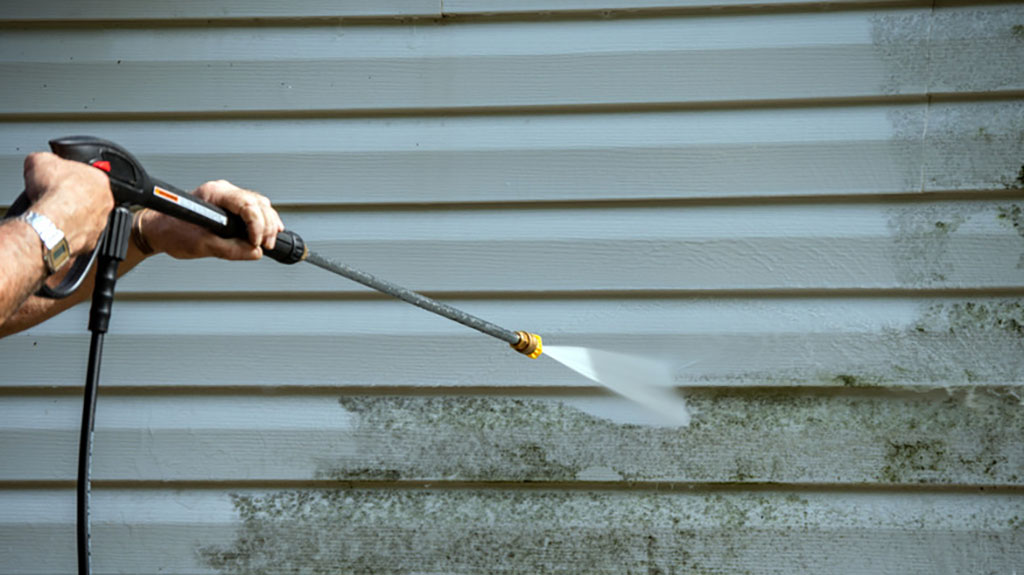Low-pressure House Washing is ideal for sensitive exteriors.
Low-pressure House Washing is ideal for sensitive exteriors.
Blog Article
Recognizing the Secret Differences Between Pressure Washing and House Washing
The difference in between pressure washing and residence washing is critical for home owners looking to keep their property's outside. While pressure washing employs high-pressure water jets to get rid of persistent gunk from robust surfaces, house washing utilizes a gentler technique that includes eco-friendly cleaning agents to shield even more delicate materials.
Definition of Pressure Washing
Pressure washing, frequently described as power washing, entails making use of high-pressure water spray to get rid of dirt, grime, mold and mildew, mold, and other contaminants from numerous surfaces. This strategy is specifically reliable on hard surface areas such as concrete, brick, and stone, making it an optimal choice for cleansing driveways, outdoor patios, and sidewalks. The procedure typically makes use of specialized tools that generates water pressure ranging from 1,500 to 3,000 psi or even more, making sure effective cleansing also in difficult problems.
Pressure washing is not limited to exterior surface areas; it can also be utilized for numerous applications, including lorries, outside furnishings, and equipment. Nevertheless, it is important to keep in mind that the intensity of the water pressure can potentially harm fragile surfaces, such as timber or repainted finishes, if not managed correctly. For that reason, picking the appropriate pressure setup and nozzle kind is crucial for optimum outcomes.
Along with surface cleaning, pressure washing can also play a significant role in maintaining the longevity of structures by preventing the buildup of unsafe impurities that can cause deterioration. In general, pressure washing works as an effective device for improving sanitation and protecting the stability of various surfaces.
Meaning of House Washing
Residence washing describes the detailed cleansing of a home's outside surface areas, making use of a mix of low-pressure water and specialized cleansing remedies. This approach is created to get rid of dirt, mold, mildew, algae, and various other impurities that accumulate with time, maintaining the aesthetic allure and structural honesty of the building.
Unlike pressure washing, which employs high-pressure streams of water, residence washing emphasizes using reduced pressure to stop damage to delicate surfaces such as home siding, roof, and painted finishes. The cleaning services utilized are normally eco-friendly and created to effectively deal with specific problems, guaranteeing a detailed tidy without compromising the atmosphere or the honesty of the products being treated.
Home washing is specifically beneficial for preserving the look of vinyl, wood, stucco, and brick outsides. Regular home washing not just improves visual allure but additionally adds to the durability of a home's outside surfaces by minimizing the effects of damaging microbes and environmental contaminants. Home owners are urged to arrange house washing regularly to guarantee their home continues to be in optimum problem, thus guarding their investment.
Secret Strategies Utilized
In the realm of exterior cleansing, go to this website numerous techniques are used to attain ideal outcomes during residence washing. The key approach involves soft washing, which uses low-pressure water integrated with specialized cleaning remedies. This technique effectively gets rid of dirt, algae, and mold without destructive fragile surface areas such as timber or repainted siding.
One more trick technique is the usage of a surface cleaner accessory, which is especially effective for level surfaces like patio areas and driveways. This tool provides consistent cleaning by utilizing revolving jets that cover a larger area, ensuring regular results.
Chemical application is additionally vital in residence washing. Cleansers such as salt hypochlorite or eco-friendly cleaning agents are often made use of to damage down hard spots and natural growth. House Washing. Appropriate dilution and application methods are necessary to decrease any type of possible damage to plants or landscape design
Appropriate Surfaces for each and every
When establishing the appropriate cleansing technique, it's important to consider the sorts of surfaces entailed. Pressure washing, which uses high-pressure water jets, is finest fit for hard, long lasting surfaces that can endure extreme pressure. Typical web link applications include driveways, patios, walkways, and decks. These surface areas frequently collect hard discolorations, such as oil, oil, and mildew, which call for the powerful cleaning action provided by pressure washing.
On the other hand, residence washing commonly uses a softer method, using low-pressure water integrated with specialized detergents. Residence washing efficiently eliminates dust, pollen, and mold without taking the chance of damage to the exterior finish.
Benefits and Downsides

On the other hand, house washing utilizes a gentler approach, often using a combination of low-pressure water and cleansing remedies. This technique is much safer for painted surface areas, exterior siding, and roofing systems, helping to protect their honesty. The key downside of residence washing is that it may not get rid of deeply ingrained dust or persistent spots as efficiently as pressure washing, which can need more time and numerous applications.

Verdict
In recap, pressure washing and house washing offer distinctive functions in exterior cleansing. Pressure washing utilizes high-pressure water streams, making it appropriate for sturdy surface areas and effective versus challenging discolorations. Conversely, residence washing makes use of a low-pressure approach with eco-friendly services, guaranteeing the safety and security of fragile materials. Recognizing these differences helps with notified choices concerning the proper cleaning method based on surface area type and condition, inevitably promoting reliable maintenance and durability of outside surfaces.
Report this page